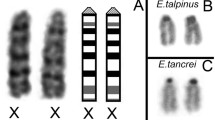Summary
The translocation mnT12(IV;X) is a fusion of holocentric chromosomes IV and X, the breakpoints occurring near the left end of IV and the right end of X. Animals homozygous for mnT12 are viable and fertile; they contain five pairs of chromosomes rather than the normal set of six pairs. The mnT12 chromosome is larger than all wild-type chromosomes and thus identifies linkage groups IV and X cytologically. Hermaphrodites heterozygous for mnT12 show high frequency meiotic nondisjunction both between mnT12 and the X chromosome, which results in a high incidence of male self progeny (27% compared to the wild-type incidence of 0.2%), and between mnT12 and chromosome IV, which results in a high incidence of self progeny essentially trisomic for chromosome IV (karyotype IV/mnT12/mnT12). The viability of chromosome IV trisomics has been confirmed by constructing animals trisomic for only normal copies of chromosome IV; these animals are morphologically wild type. Meiotic chromosome disjunction in mnT12 homozygotes appears to be normal, although the frequency of recombination between markers that are normally X-linked is significantly reduced. Males of genotype IV/mnT12/0 are fertile. They can be thought of as having a neo-X(mnT12) neo-Y(normal IV) karyotype since it is possible to maintain a male-hermaphrodite stock of C. elegans consisting of such males and hermaphrodites carrying two neo-X chromosomes and no neo-Y; the organism is thus converted from an XO:XX type of sex determination to an XX:XX system.
Similar content being viewed by others
References
Albertson DG (1984) Localization of the ribosomal genes in Caenorhabditis elegans chromosomes by in situ hybridization using biotin-labeled probes. EMBO J 3:1227–1234
Albertson DG, Thomson JN (1982) The kinetochores of Caenorhabditis elegans. Chromosoma 86:409–428
Brenner S (1974) The genetics of Caenorhabditis elegans. Genetics 77:71–94
Goldstein P, Slaton DE (1982) Synaptonemal complexes of Caenorhabditis elegans. Comparison of wild type and mutant strains and pachytene karyotype analysis of wild type. Chromosoma 84:585–597
Herman RK (1978) Crossover suppressors and balanced recessive lethals in Caenorhabditis elegans. Genetics 88:49–65
Herman RK, Albertson DG, Brenner S (1976) Chromosome rearrangements in Caenorhabditis elegans. Genetics 83:91–105
Herman RK, Madl JE, Kari CK (1979) Duplications in Caenorhabditis elegans. Genetics 92:419–435
Herman RK, Kari CK, Hartman PS (1982) Dominant X-chromosome nondisjunction mutants of Caenorhabditis elegans. Genetics 102:379–400
Hodgkin J (1980) More sex-determination mutants of Caenorhabditis elegans. Genetics 96:649–664
Hodgkin J, Horvitz HR, Brenner S (1979) Nondisjunction mutants of the nematode Caenorhabditis elegans. Genetics 91:67–94
Horvitz HR, Brenner S, Hodgkin J, Herman RK (1979) A uniform genetic nomenclature for the nematode Caenorhabditis elegans. Mol Gen Genet 175:129–133
Mainland DL, Herrera L, Sutcliffe MI (1956) Statistical tables for use with binomial samples, contingency tests, confidence limits and sample size estimates. Department of Medical Statistics, New York University School of Medicine
Meneely PM, Herman RK (1981) Suppression and function of X-linked lethal and sterile mutations in Caenorhabditis elegans. Genetics 97:65–84
Nigon V, Brun J (1955) L'evolution des structures nucléaires dans l'ovogenèse de Caenorhabditis elegans maupas 1900. Chromosoma 7:129–169
Rose AM, Baillie DL, Curran J (1984) Meiotic pairing behavior of two free duplications of linkage group I in Caenorhabditis elegans. Mol Gen Genet 195:52–56
Rosenbluth RE, Cuddeford C, Baillie DL (1985) Mutagenesis in Caenorhabditis elegans II. A spectrum of mutational events induced with 1500r of γ-radiation. Genetics 109:493–511
Sigurdson DC, Spanier GJ, Herman RK (1984) Caenorhabditis elegans deficiency mapping. Genetics 108:331–345
Sternberg PW, Horvitz HR (1984) The genetic control of cell lineage during nematode development. Annu Rev Genet 18:489–524
Swanson MM, Edgley ML, Riddle DL (1984) Caenorhabditis elegans. In: O'Brien SJ (ed) Genetic maps 1984. Cold Spring Harbor Laboratory, Cold Spring Harbor, New York, 286–299
von Wettstein D, Rasmussen SW, Holm PB (1984) The synaptonemal complex in genetic segregation. Annu Rev Genet 18:331–413
White MJD (1973) Animal cytology and evolution, 3rd ed. Cambridge University Press, Cambridge
Author information
Authors and Affiliations
Additional information
Communicated by G.R. Smith
Rights and permissions
About this article
Cite this article
Sigurdson, D.C., Herman, R.K., Horton, C.A. et al. An X-autosome fusion chromosome of Caenorhabditis elegans . Mol Gen Genet 202, 212–218 (1986). https://doi.org/10.1007/BF00331639
Received:
Issue Date:
DOI: https://doi.org/10.1007/BF00331639




